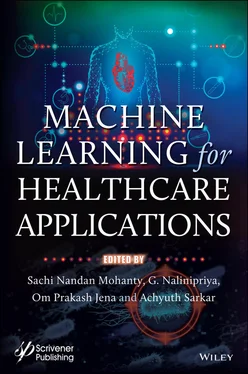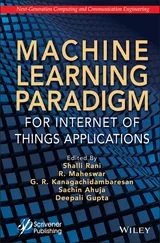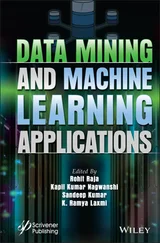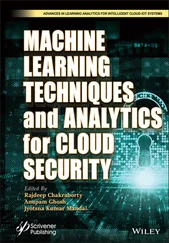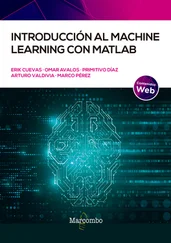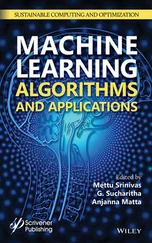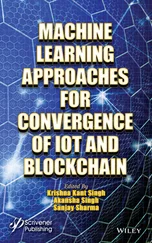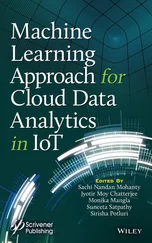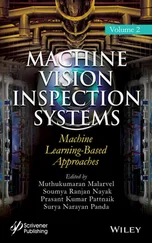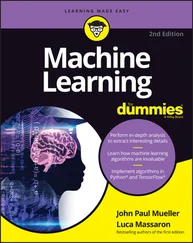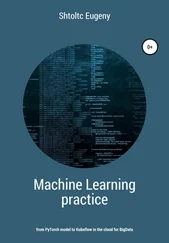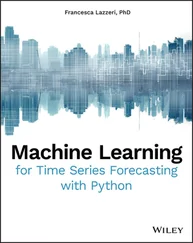1 Cover
2 Title Page
3 Copyright
4 Preface
5 Part 1: INTRODUCTION TO INTELLIGENT HEALTHCARE SYSTEMS 1 Innovation on Machine Learning in Healthcare Services—An Introduction 1.1 Introduction 1.2 Need for Change in Healthcare 1.3 Opportunities of Machine Learning in Healthcare 1.4 Healthcare Fraud 1.5 Fraud Detection and Data Mining in Healthcare 1.6 Common Machine Learning Applications in Healthcare 1.7 Conclusion References
6 Part 2: MACHINE LEARNING/DEEP LEARNING-BASED MODEL DEVELOPMENT 2 A Framework for Health Status Estimation Based on Daily Life Activities Data Using Machine Learning Techniques 2.1 Introduction 2.2 Background 2.3 Problem Statement 2.4 Proposed Architecture 2.5 Experimental Results 2.6 Conclusion References 3 Study of Neuromarketing With EEG Signals and Machine Learning Techniques 3.1 Introduction 3.2 Literature Survey 3.3 Methodology 3.4 System Setup & Design 3.5 Result 3.6 Conclusion References 4 An Expert System-Based Clinical Decision Support System for Hepatitis-B Prediction & Diagnosis 4.1 Introduction 4.2 Outline of Clinical DSS 4.3 Background 4.4 Proposed Expert System-Based CDSS 4.5 Implementation & Testing 4.6 Conclusion References 5 Deep Learning on Symptoms in Disease Prediction 5.1 Introduction 5.2 Literature Review 5.3 Mathematical Models 5.4 Learning Representation From DSN 5.5 Results and Discussion 5.6 Conclusions and Future Scope References 6 Intelligent Vision-Based Systems for Public Safety and Protection via Machine Learning Techniques 6.1 Introduction 6.2 Public Safety and Video Surveillance Systems 6.3 Machine Learning for Public Safety 6.4 Securing the CCTV Data 6.5 Conclusion References 7 Semantic Framework in Healthcare 7.1 Introduction 7.2 Semantic Web Ontology 7.3 Multi-Agent System in a Semantic Framework Instance Data 7.4 Conclusion References 8 Detection, Prediction & Intervention of Attention Deficiency in the Brain Using tDCS 8.1 Introduction 8.2 Materials & Methods 8.3 Results & Discussion 8.4 Conclusion Acknowledgement References 9 Detection of Onset and Progression of Osteoporosis Using Machine Learning 9.1 Introduction 9.2 Microwave Characterization of Human Osseous Tissue 9.3 Prediction Model of Osteoporosis Using Machine Learning Algorithms 9.4 Conclusion Acknowledgment References 10 Applications of Machine Learning in Biomedical Text Processing and Food Industry 10.1 Introduction 10.2 Use Cases of AI and ML in Healthcare 10.3 Use Cases of AI and ML in Food Technology 10.4 A Case Study: Sentiment Analysis of Drug Reviews 10.5 Results and Analysis 10.6 Conclusion References 11 Comparison of MobileNet and ResNet CNN Architectures in the CNN-Based Skin Cancer Classifier Model 11.1 Introduction 11.2 Our Skin Cancer Classifier Model 11.3 Skin Cancer Classifier Model Results 11.4 Hyperparameter Tuning and Performance 11.5 Comparative Analysis and Results 11.6 Conclusion References 12 Deep Learning-Based Image Classifier for Malaria Cell Detection 12.1 Introduction 12.2 Related Work 12.3 Proposed Work 12.4 Results and Evaluation 12.5 Conclusion References 13 Prediction of Chest Diseases Using Transfer Learning 13.1 Introduction 13.2 Types of Diseases 13.3 Diagnosis of Lung Diseases 13.4 Materials and Methods 13.5 Results and Discussions 13.6 Conclusion References 14 Early Stage Detection of Leukemia Using Artificial Intelligence 14.1 Introduction 14.2 Literature Review 14.3 Proposed Work 14.4 Conclusion and Future Aspects References
7 Part 3: INTERNET OF MEDICAL THINGS (IOMT) FOR HEALTHCARE 15 IoT Application in Interconnected Hospitals 15.1 Introduction 15.2 Networking Systems Using IoT 15.3 What are Smart Hospitals? 15.4 Assets 15.5 Threats 15.6 Conclusion References 16 Real Time Health Monitoring Using IoT With Integration of Machine Learning Approach 16.1 Introduction 16.2 Related Work 16.3 Existing Healthcare Monitoring System 16.4 Methodology and Data Analysis 16.5 Proposed System Architecture 16.6 Machine Learning Approach 16.7 Work Flow of the Proposed System 16.8 System Design of Health Monitoring System 16.9 Use Case Diagram 16.10 Conclusion References
8 Part 4: MACHINE LEARNING APPLICATIONS FOR COVID-19 17 Semantic and NLP-Based Retrieval From Covid-19 Ontology 17.1 Introduction 17.2 Related Work 17.3 Proposed Retrieval System 17.4 Conclusion References 18 Semantic Behavior Analysis of COVID-19 Patients: A Collaborative Framework 18.1 Introduction 18.2 Related Work 18.3 Methodology 18.4 Conclusion References 19 Comparative Study of Various Data Mining Techniques Towards Analysis and Prediction of Global COVID-19 Dataset 19.1 Introduction 19.2 Literature Review 19.3 Materials and Methods 19.4 Experimental Results 19.5 Conclusion and Future Scopes References 20 Automated Diagnosis of COVID-19 Using Reinforced Lung Segmentation and Classification Model 20.1 Introduction 20.2 Diagnosis of COVID-19 20.3 Genetic Algorithm (GA) 20.4 Related Works 20.5 Challenges in GA 20.6 Challenges in Lung CT Segmentation 20.7 Proposed Diagnosis Framework 20.8 Result Discussion 20.9 Conclusion References
9 Part 5: CASE STUDIES OF APPLICATION AREAS OF MACHINE LEARNING IN HEALTHCARE SYSTEM 21 Future of Telemedicine with ML: Building a Telemedicine Framework for Lung Sound Detection 21.1 Introduction 21.2 Related Work 21.3 Strategic Model for Telemedicine 21.4 Framework for Lung Sound Detection in Telemedicine 21.5 Experimental Analysis 21.6 Conclusion References 22 A Lightweight Convolutional Neural Network Model for Tuberculosis Bacilli Detection From Microscopic Sputum Smear Images 22.1 Introduction 22.2 Literature Review 22.3 Proposed Work 22.4 Experimental Results and Discussion 22.5 Conclusion References 23 Role of Machine Learning and Texture Features for the Diagnosis of Laryngeal Cancer 23.1 Introduction 23.2 Clinically Correlated Texture Features 23.3 Machine Learning Techniques 23.4 Result Analysis and Discussions 23.5 Conclusions References 24 Analysis of Machine Learning Technologies for the Detection of Diabetic Retinopathy 24.1 Introduction 24.2 Related Work 24.3 Dataset Used 24.4 Methodology Used 24.5 Analysis of Results and Discussion 24.6 Conclusion References
10 Index
11 End User License Agreement
1 Chapter 2 Table 2.1 Sample Dataset for Phase-I. Table 2.2 Accuracy of the model Table 2.3 Precision of the model. Table 2.4 Recall of the model. Table 2.5 F1-score of the model.
2 Chapter 4 Table 4.1 Sample rule set for the proposed expert system.
3 Chapter 5Table 5.1 Description of network architecture.Table 5.2 Description of the hyper parameters.
4 Chapter 6Table 6.1 Comparison of existing software apps.Table 6.2 Comparison of previous approaches.Table 6.3 Comparison of various DCNNs.
5 Chapter 7Table 7.1 Examples of some types of ontologies.
6 Chapter 8Table 8.1 Age & Gender of Subjects.Table 8.2 Percentage of Correct Answers in AB task and α of subjects according t...
7 Chapter 9Table 9.1 Electrical properties of human tissue.Table 9.2 Dataset creation.Table 9.3 Tabular representation of Classification Reports using KNN, Decision T...
8 Chapter 10Table 10.1 Performance of SA on drug reviews using ML models.
9 Chapter 11Table 11.1 Classification report of our machine learning model.Table 11.2 Summary of hyper parameter tuning.
10 Chapter 12Table 12.1 Classification Report.
11 Chapter 13Table 13.1 Causes and symptoms for pneumothorax, pneumonia, pleural effusion and...Table 13.2 Causes and symptoms for nodule, mass, cardiomegaly, edema and consoli...Table 13.3 Causes and symptoms for pleural thickening, infiltration, fibrosis an...Table 13.4 Comparison of true label and predicted label for various diseases.
12 Chapter 14Table 14.1 Difference between acute stage and chronic stages of leukemia.
13 Chapter 16Table 16.1 Patient’s condition for decision making.
Читать дальше
